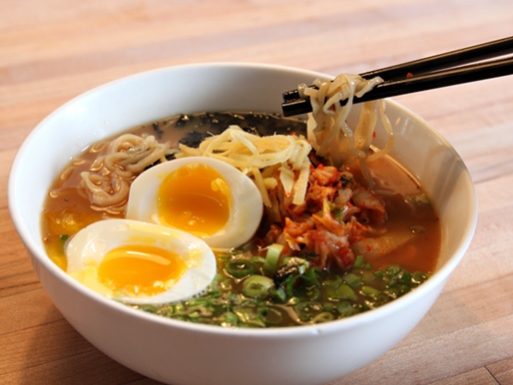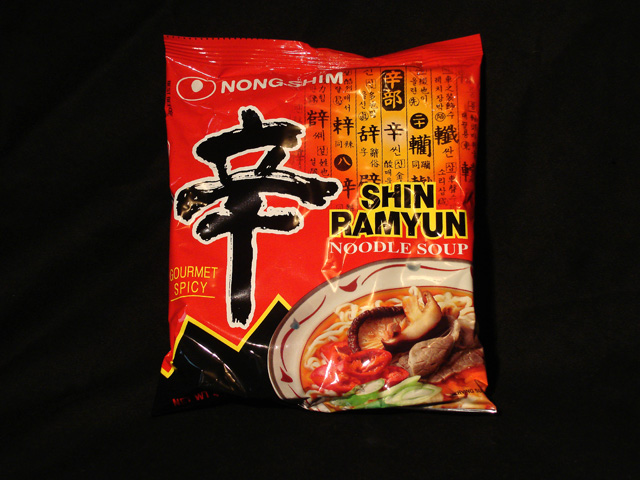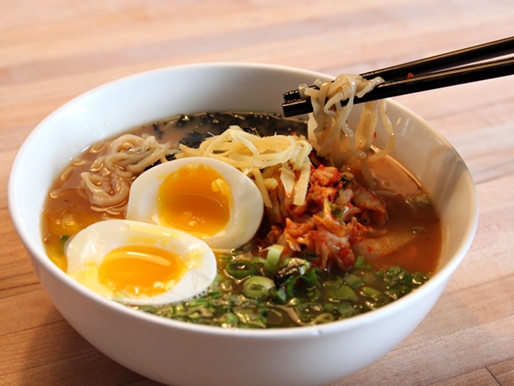Diatonic Degustation: Celebration Ramen

Food. Music. Recipes.
By Adam Berkelmans
It’s cold outside. Looking out the window, I see my neighbourhood draped in snow. Cars are moving in slow motion and people are walking with their faces down in the type of trudge you must only ever see in northern winter cities. All in all it’s a good day to stay inside, a good day for soup.
The process of soup-making can be greatly enhanced by choosing the right background music and today I’m feeling something energetic and happy. It’s daytime right now and slower wintery folk like Deep Dark Woods or Hayden feels more like an evening thing. Japandroids it is. They maintain that perfect blend of Canadian punk and classic rock undertones that flew off the west coast and hit radios everywhere in 2012 with their album Celebration Rock. The energy on this album is infectious, the type of music that, when listened to while driving, causes your foot to push the gas pedal until you’re somehow going 130 km/h in a 50. As the sounds of fireworks come through the speaker and the first guitar riff makes its entrance, I’m feeling instantly more animated and lively.
Now for the soup: like music, there are endless soup possibilities, literally hundreds of options to choose from in each country on earth, but today’s music choice pulls my mind to the Far East. Japan, known as the Land of Soups (no it’s not), is home to a wide range of different soups and stews, but I’m still thinking energetic and happy. I’m thinking ramen.
The song “Fire’s Highway” propels me into kitchen, I’m already picturing my soon to be soup… a knock-David-Chang-on-his-ass-make-a-grown-Japanese-noodle-maker-cry kind of soup. I look in my cupboards, ready to pull out the 50 ingredients that go into a good ramen.
I have 6 of them.
Fuck it — I’ll just make packaged ramen.

Instant ramen noodles, popular with harried moms, broke students, bachelors and most of Asia were invented back in the 1950s by the Japanese. By flash frying cooked noodles, companies were able to preserve them, giving them an almost indefinite shelf life. Ironically, instant ramen started out as a luxury item, its initial price being somewhere around 39 cents — the same price as a pack of Mr. Noodles today! Fresh noodles at that time were just way cheaper, but the idea took hold and people started buying instant ramen in droves.
This has never stopped.
Nearly 100 billion packages of instant noodles are eaten every year, by people in every continent. There are nearly as many types of instant ramen as people who eat it and most are pretty decent. I find the $0.99-$1.99 ones to be the best tasting, but really it’s all subjective. In Japan, the noodles are made in large factories by a combination of robotic machines and human workers… Japandroids?
I reach around in the cupboard and blindly pull out a package of ramen. It’s a Korean Nongshim Shin Ramyun brand pack of spicy noodles. Since fate, laziness and a lack of decent restaurant ramen in town forced me to eat the instant kind, the least I could do is amp them up a little bit. What I do happen to have in my fridge/pantry that would go well with the ramen are as follows: Sesame oil, home made kimchi, green onion, eggs, and gochujang paste. Another combination that could work for you condiment lovers out there would be: fish sauce, sriracha, cilantro, lime and canned/frozen corn. Or miso paste, frozen edamame (shucked), eggs, leftover pork or chicken (sliced thinly) and spinach. Really, it’s whatever you have on hand that would be tasty added to your soup.
The best part of instant ramen? Even with my additions it’s still done before the album ends, and I get to slurp back noodles (irreparably damaging the inside of my mouth with the lava-hot broth) while rocking out to “The House That Heaven Built” and “Continuous Thunder.”
Here’s the “recipe” for my meal today, Korean-style augmented instant ramen:
Celebration Ramen
– 1 package of spicy style instant ramen
– 1 egg
– 1 tablespoon of gochujang (sold in all Korean and many pan-Asian grocery stores in a red tub, it’s a spicy fermented pepper paste and is ubiquitous in Korean cuisine)
– 1 green or spring onion
– Big forkful of homemade or store bought kimchi (Korean spicy pickled cabbage)
– 1 teaspoon sesame oil
- Grab a small pot and fill it with enough water to cover an egg by an inch or two.
- Bring that pot to a boil. Once boiling, set a timer for 5 minutes and gently put your egg into the pot, best way is to use a spoon.
- While the egg is boiling, slice up a green onion using a knife, or a pair of scissors, throwing out the root end and the very tip of the green end.
- Fill a bowl with very cold water.
- Once the 5 minutes is up, immediately dump out the hot water and move the egg to the cold water, leaving it for at least 1 minute to stop it cooking from the inside.
- Fill the pot back up with 2 cups of water.
- Bring that water back to a boil. In the meantime, carefully peel your egg.
- Once the water is boiling, add the gochujang, noodles and spice pack and stir it up.
- After 1 or 2 minutes eat one of the noodles to test for doneness. If ready, add the kimchi and stir.
- Take the soup off the heat and transfer to a bowl. Sprinkle on the green onions and sesame oil. Place the egg on top and whack it with a spoon, it should break open and let out some of its perfectly soft yolk.
- Enjoy!

